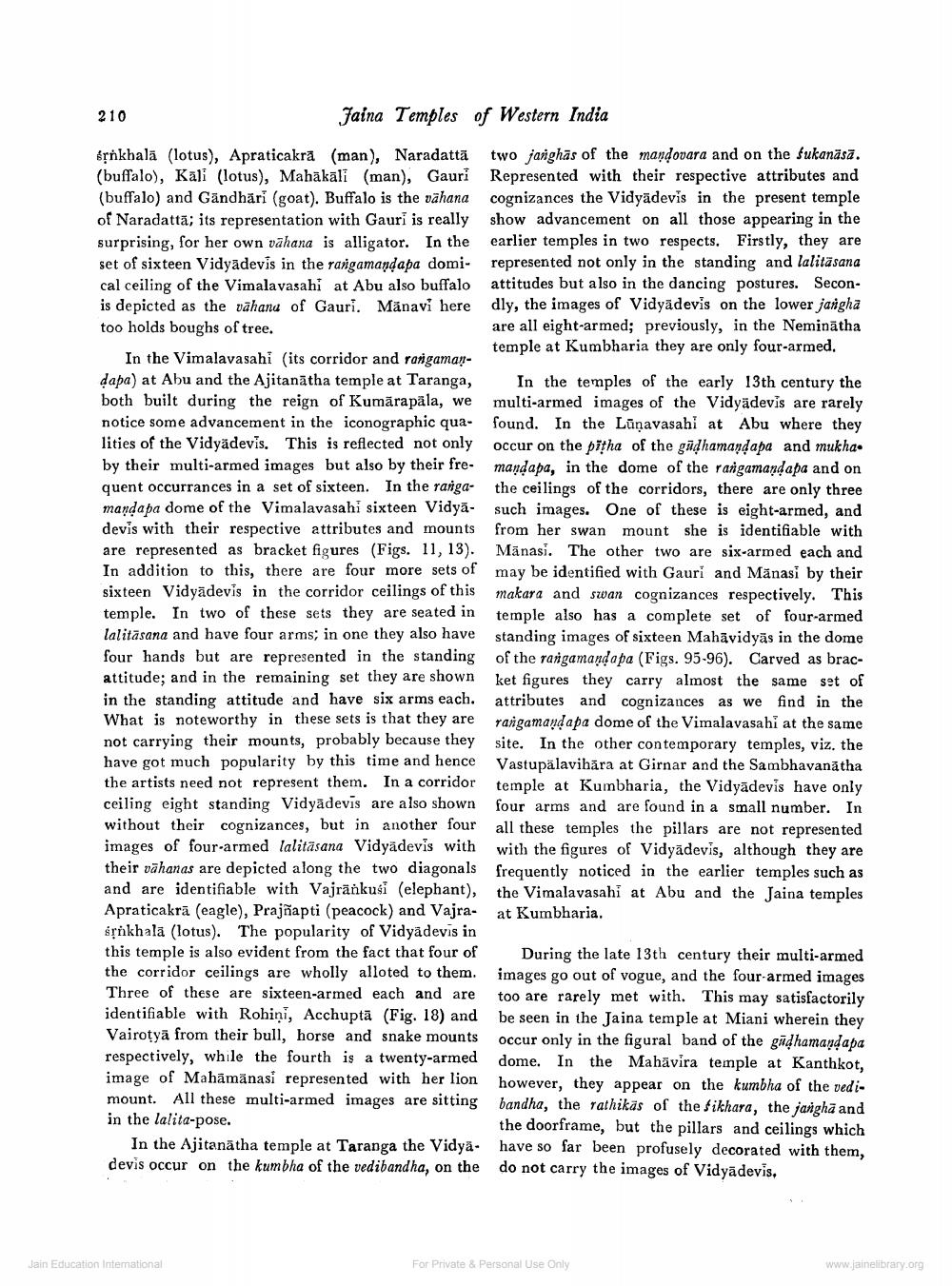________________
210
Jaina Temples of Western India
&țnkbalā (lotus), Apraticakra (man), Naradatta two janghās of the mandovara and on the Sukanäsā. (buffalo), Kali (lotus), Mahakali (man), Gauri Represented with their respective attributes and (buffalo) and Gandhari (goat). Buffalo is the vāhana cognizances the Vidyadevis in the present temple of Naradatta; its representation with Gauri is really show advancement on all those appearing in the surprising, for her own vāhana is alligator. In the earlier temples in two respects. Firstly, they are set of sixteen Vidyadevis in the rangamandapa domi- represented not only in the standing and lalitasana cal ceiling of the Vimalavasahi at Abu also buffalo attitudes but also in the dancing postures. Seconis depicted as the vāhand of Gauri. Mänavi heredly, the images of Vidyādevis on the lower jangha too holds boughs of tree.
are all eight-armed; previously, in the Neminätha
temple at Kumbharia they are only four-armed, In the Vimalavasahi (its corridor and rarigamandapa) at Abu and the Ajitanātha temple at Taranga, In the temples of the early 13th century the both built during the reign of Kumārapāla, we multi-armed images of the Vidyadevis are rarely notice some advancement in the iconographic qua- found. In the Lūņavasahi at Abu where they lities of the Vidyädevis. This is reflected not only occur on the pitha of the gidhamandapa and mukha. by their multi-armed images but also by their fre- mandapa, in the dome of the rangamandapa and on quent occurrances in a set of sixteen. In the ranga- the ceilings of the corridors, there are only three manda pa dome of the Vimalavasahi sixteen Vidyā- such images. One of these is eight-armed, and devis with their respective attributes and mounts from her swan mount she is identifiable with are represented as bracket figures (Figs. 11, 13). Mānasi. The other two are six-armed each and In addition to this, there are four more sets of may be identified with Gauri and Mänasi by their sixteen Vidyädevis in the corridor ceilings of this makara and swan cognizances respectively. This temple. In two of these sets they are seated in temple also has a complete set of four-armed lalitäsana and have four arms; in one they also have standing images of sixteen Mahavidyās in the dome four hands but are represented in the standing of the rarigamandapa (Figs. 95-96). Carved as bracattitude; and in the remaining set they are shown ket figures they carry almost the same set of in the standing attitude and have six arms each. attributes and cognizances as we find in the What is noteworthy in these sets is that they are rangamandapa dome of the Vimalavasahi at the same not carrying their mounts, probably because they site. In the other contemporary temples, viz, the have got much popularity by this time and hence Vastupälavihāra at Girnar and the Sambhavanātha the artists need not represent them. In a corridor temple at Kumbharia, the Vidyādevis have only ceiling eight standing Vidyādevis are also shown four arms and are found in a small number. In without their cognizances, but in another four all these temples the pillars are not represented images of four-armed lalitäsana Vidyadevis with with the figures of Vidyadevis, although they are their vāhanas are depicted along the two diagonals frequently noticed in the earlier temples such as and are identifiable with Vajränkusi (elephant), the Vimalavasahi at Abu and the Jaina temples Apraticakrā (eagle), Prajñapti (peacock) and Vajra- at Kumbharia. sțnkhala (lotus). The popularity of Vidyadevis in this temple is also evident from the fact that four of During the late 13th century their multi-armed the corridor ceilings are wholly alloted to them. images go out of vogue, and the four-armed images Three of these are sixteen-armed each and are too are rarely met with. This may satisfactorily identifiable with Rohini, Acchuptā (Fig. 18) and be seen in the Jaina temple at Miani wherein they Vairotyā from their bull, horse and snake mounts occur only in the figural band of the gūdhamandapa respectively, while the fourth is a twenty-armed dome. In the Mahavira temple at Kanthkot, image of Mahämänasi represented with her lion however, they appear on the kumbha of the vedimount. All these multi-armed images are sitting bandha, the rathikäs of the Sikhara, the jangha and in the lalita-pose.
the doorframe, but the pillars and ceilings which In the Ajitanātha temple at Taranga the Vidya. have so far been profusely decorated with them, devis occur on the kumbha of the vedibandha, on the do not carry the images of Vidyadevis.
Jain Education International
For Private & Personal Use Only
www.jainelibrary.org




